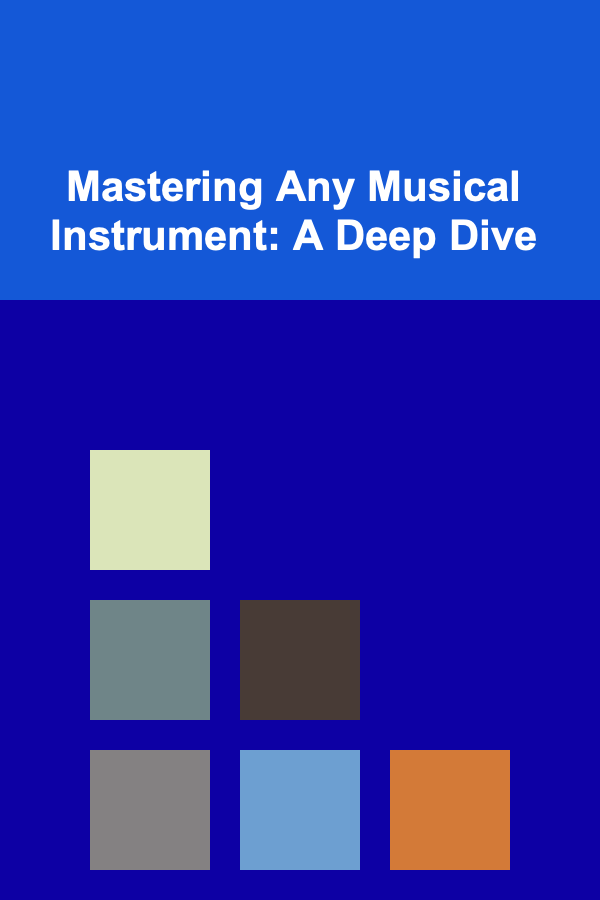
Mastering Any Musical Instrument: A Deep Dive
ebook include PDF & Audio bundle (Micro Guide)
$12.99$9.99
Limited Time Offer! Order within the next:

Learning a musical instrument is a journey of dedication, perseverance, and joy. It's a path that can lead to immense personal satisfaction, creative expression, and a deeper appreciation for the art of music. However, the path to mastery can seem daunting, filled with technical challenges, plateaus, and moments of frustration. This article aims to provide a comprehensive guide to navigating this journey, offering practical strategies and insights into how to effectively learn and master any musical instrument.
I. Foundational Principles: Building a Solid Base
Before diving into specific techniques and exercises, it's crucial to establish a strong foundation based on several core principles. These principles will guide your learning process and ensure that you are building skills in a sustainable and effective manner.
A. The Power of Consistent Practice
The cornerstone of musical mastery is consistent practice. "Practice makes perfect" is a cliché, but it holds profound truth. It's not just about the amount of practice, but the quality and frequency of your sessions. Shorter, more frequent practice sessions are generally more effective than long, infrequent ones. Aim for daily practice, even if it's only for 20-30 minutes. This consistency allows your brain to consolidate new information and motor skills more effectively.
Think of it like building a brick wall. Laying a few bricks every day will eventually result in a strong, sturdy wall. Trying to lay hundreds of bricks at once will likely lead to mistakes, fatigue, and ultimately, a weaker structure. Consistency is the key to long-term progress.
B. Goal Setting: Defining Your Musical Vision
Without clear goals, your practice can become aimless and demotivating. Set both short-term and long-term goals. Short-term goals might include mastering a specific scale, learning a particular chord progression, or improving your sight-reading ability. Long-term goals could involve performing a challenging piece, joining a band, or composing your own music.
Make your goals SMART: Specific, Measurable, Achievable, Relevant, and Time-bound. For example, instead of saying "I want to be a better guitarist," a SMART goal would be "I will learn to play the solo from 'Comfortably Numb' by Pink Floyd by practicing 30 minutes a day, 5 days a week, for the next 3 months."
C. The Importance of Listening
Active listening is an essential skill for any musician. Listen to a wide variety of music in the style you're learning, as well as music from different genres. Pay attention to the nuances of performance, the interplay between instruments, and the overall structure of the music. This will not only inspire you but also help you develop a deeper understanding of music theory and performance techniques.
Transcribe music by ear. Even attempting to transcribe a simple melody can dramatically improve your ear training and understanding of musical intervals and rhythms. Use online resources and ear-training apps to further develop this crucial skill.
D. The Role of Music Theory
While it's possible to learn an instrument without formal music theory training, understanding the underlying principles of music theory can significantly accelerate your progress and deepen your musical understanding. Music theory provides a framework for understanding how music works, including scales, chords, harmony, and rhythm.
Start with the basics: learn about scales, chords, intervals, and key signatures. As you progress, delve into more advanced topics such as harmony, counterpoint, and orchestration. There are numerous resources available online and in libraries, including textbooks, online courses, and video tutorials.
E. Patience and Perseverance
Learning a musical instrument takes time and effort. There will be moments of frustration, plateaus in progress, and setbacks. It's important to be patient with yourself and to persevere through these challenges. Remember why you started learning in the first place, and focus on the joy of making music. Celebrate your small victories and learn from your mistakes. Don't give up!
II. Effective Practice Techniques: Optimizing Your Time
Once you have a solid foundation, it's time to focus on developing effective practice techniques. These techniques will help you maximize your time and effort, ensuring that you are making consistent progress towards your goals.
A. Slow and Steady Wins the Race
Resist the temptation to rush through exercises or pieces. Start slowly, focusing on accuracy and precision. Use a metronome to maintain a consistent tempo. As you become more comfortable, gradually increase the tempo. Playing slowly allows you to identify and correct mistakes early on, preventing them from becoming ingrained habits.
This principle applies to both technical exercises and musical pieces. Break down complex passages into smaller, manageable sections. Practice each section slowly and accurately before putting them together.
B. Focused Practice: Identifying Weaknesses
Don't just mindlessly repeat the same exercises over and over again. Identify your weaknesses and focus your practice on those areas. Are you struggling with a particular chord change? Are you having difficulty with a specific rhythm? Are you making frequent mistakes in a certain passage?
Once you've identified your weaknesses, create specific exercises to address them. For example, if you're struggling with a chord change, practice that chord change repeatedly, focusing on smooth transitions and accurate finger placement. If you're having difficulty with a specific rhythm, isolate that rhythm and practice it separately, using a metronome to maintain accuracy.
C. Active Recall: Testing Your Knowledge
Active recall is a powerful learning technique that involves actively retrieving information from memory. Instead of passively rereading notes or watching videos, test yourself regularly on the material you've learned.
For example, if you're learning scales, try to play them from memory without looking at a chart. If you're learning chords, try to identify them by ear. If you're learning a piece of music, try to play it from memory without looking at the sheet music. Active recall forces your brain to work harder, strengthening your memory and understanding.
D. Spaced Repetition: Reinforcing Learning Over Time
Spaced repetition is a learning technique that involves reviewing material at increasing intervals. This technique is based on the principle that information is more likely to be remembered if it is reviewed repeatedly over time.
For example, if you learn a new scale, review it the next day, then again a few days later, then again a week later, and so on. This spaced repetition will help to reinforce your learning and ensure that you retain the information for longer.
E. Vary Your Practice: Preventing Boredom and Burnout
Practicing the same exercises over and over again can lead to boredom and burnout. To prevent this, vary your practice routine. Alternate between technical exercises, musical pieces, improvisation, and ear training. Explore different genres of music and experiment with different techniques.
This variety will not only keep your practice interesting and engaging but also help you develop a more well-rounded musical skill set.
III. Instrument-Specific Considerations: Tailoring Your Approach
While the foundational principles and effective practice techniques discussed above are applicable to learning any musical instrument, there are also specific considerations that are unique to each instrument. Understanding these considerations is crucial for tailoring your approach and maximizing your progress.
A. String Instruments (Guitar, Violin, Cello, etc.)
- Finger Dexterity and Coordination: String instruments require a high degree of finger dexterity and coordination. Focus on developing these skills through exercises such as scales, arpeggios, and chord changes.
- Intonation: Accurate intonation is crucial for playing string instruments in tune. Use a tuner regularly to check your intonation and train your ear to recognize when a note is out of tune.
- Bow Technique (for bowed instruments): Proper bow technique is essential for producing a good tone and achieving dynamic control. Work with a teacher to develop a solid bow technique.
- Calluses: Building calluses on your fingertips is necessary for playing string instruments comfortably. This takes time and consistent practice.
B. Keyboard Instruments (Piano, Keyboard, Organ, etc.)
- Hand Independence: Keyboard instruments require a high degree of hand independence. Practice exercises that require each hand to play different rhythms and melodies.
- Reading Music: Keyboard players need to be proficient at reading music, as most keyboard repertoire is written in staff notation.
- Coordination: Coordinating hands, feet (for organ), and musical interpretation requires dedicated and varied practice.
- Scales and Arpeggios: Mastering scales and arpeggios in all keys is essential for developing finger dexterity and keyboard technique.
C. Wind Instruments (Flute, Clarinet, Trumpet, Trombone, etc.)
- Breath Control: Wind instruments require excellent breath control. Practice breathing exercises to improve your lung capacity and control.
- Embouchure: Developing a proper embouchure (the way you shape your mouth and lips) is crucial for producing a good tone. Work with a teacher to develop a solid embouchure.
- Intonation: Maintaining accurate intonation can be challenging on wind instruments. Use a tuner regularly to check your intonation and train your ear to recognize when a note is out of tune.
- Air Support: Proper air support is crucial for playing wind instruments with power and control.
D. Percussion Instruments (Drums, Xylophone, Timpani, etc.)
- Rhythm and Timing: Percussion instruments require a strong sense of rhythm and timing. Practice with a metronome to develop your rhythmic accuracy.
- Coordination: Many percussion instruments require a high degree of coordination. Practice exercises that require you to use different limbs independently.
- Technique: Developing proper technique is crucial for producing a good sound and avoiding injuries. Work with a teacher to develop a solid technique.
- Listening to the Ensemble: Percussionists need to be acutely aware of the other instruments in the ensemble and play in a way that complements their sound.
IV. Seeking Guidance and Feedback: The Importance of a Teacher
While it's possible to learn an instrument on your own, working with a qualified teacher can significantly accelerate your progress and help you avoid common pitfalls. A good teacher can provide personalized instruction, identify your weaknesses, and offer constructive feedback. They can also provide motivation and encouragement when you're feeling discouraged.
A. Finding the Right Teacher
Choosing the right teacher is crucial. Look for a teacher who has experience teaching students of your level and who specializes in the style of music you're interested in learning. It's also important to find a teacher who you connect with personally and who motivates you to learn.
Consider these factors when choosing a teacher:
- Qualifications: Does the teacher have formal training or a proven track record of success?
- Experience: How long has the teacher been teaching?
- Teaching Style: Does the teacher's teaching style match your learning style?
- Personality: Do you feel comfortable and motivated by the teacher's personality?
- Reviews/Testimonials: What do other students say about the teacher?
B. Utilizing Online Resources
Even with a teacher, online resources can be a valuable supplement to your learning. There are numerous websites, YouTube channels, and online courses that offer instruction on various musical instruments. However, be discerning about the quality of the information you find online. Look for resources that are created by reputable musicians and educators.
Some useful online resources include:
- YouTube: Search for tutorials, demonstrations, and performances by experienced musicians.
- Online Courses: Platforms like Coursera, Udemy, and Skillshare offer a wide range of music courses.
- Music Theory Websites: Websites like Teoria.com and musictheory.net offer free resources for learning music theory.
- Sheet Music Websites: Websites like Musicnotes.com and SheetMusicPlus.com offer a vast selection of sheet music.
C. Performing and Recording Yourself
Performing for others, even if it's just for friends and family, is a great way to build confidence and get feedback. Recording yourself playing can also be very helpful, as it allows you to objectively evaluate your performance and identify areas for improvement. It's often surprising how much you can learn about your playing by simply listening back to a recording.
Don't be afraid to share your music with others and to ask for constructive criticism. This feedback can be invaluable in helping you to improve your playing.
V. Beyond Technique: Developing Musicianship
Mastering a musical instrument is not just about technical proficiency. It's also about developing your musicianship, which encompasses your understanding of music theory, your ability to express yourself through music, and your overall artistic vision.
A. Improvisation: Unleashing Your Creativity
Improvisation is the art of creating music spontaneously. It's a powerful tool for developing your musical creativity, improving your ear training, and deepening your understanding of music theory. Start by improvising simple melodies over basic chord progressions. As you become more comfortable, experiment with different scales, rhythms, and harmonies.
Don't be afraid to make mistakes. Improvisation is all about experimentation and exploration. The more you improvise, the better you'll become at expressing yourself through music.
B. Composition: Creating Your Own Music
Composition is the art of writing music. It's a challenging but rewarding process that can help you to develop a deeper understanding of music theory, improve your ear training, and express your unique musical vision. Start by writing simple melodies or chord progressions. As you become more comfortable, experiment with different forms, harmonies, and orchestrations.
There are many different approaches to composition. Some composers start with a melody, while others start with a chord progression or a rhythmic idea. Experiment with different approaches and find what works best for you.
C. Collaboration: Making Music with Others
Making music with others is a rewarding experience that can help you to improve your musicianship, build your confidence, and expand your musical horizons. Join a band, orchestra, or choir. Participate in jam sessions. Collaborate with other musicians on songwriting projects. Working with others will expose you to new ideas and perspectives and help you to become a more well-rounded musician.
Collaboration is also a great way to build friendships and connect with other people who share your passion for music.
VI. Conclusion: The Lifelong Journey of Musical Mastery
Mastering a musical instrument is a lifelong journey. There will always be new skills to learn, new challenges to overcome, and new musical horizons to explore. Embrace the journey and enjoy the process of learning and growing as a musician. Remember that progress is not always linear. There will be times when you feel like you're not making any progress, but don't give up. Keep practicing, keep learning, and keep making music. The rewards of musical mastery are well worth the effort.
By following the principles and techniques outlined in this article, you can effectively learn and master any musical instrument. Remember to be consistent, set clear goals, practice effectively, seek guidance and feedback, and embrace the joy of making music. With dedication, perseverance, and a passion for music, you can achieve your musical dreams.
Reading More From Our Other Websites
- [Organization Tip 101] How to Incorporate Storage Solutions into Your Furniture
- [Home Budget 101] How to Budget for a Home Renovation Project and Stay on Track
- [Personal Investment 101] How to Create an AI-Powered App for Passive Income
- [Needle Felting Tip 101] Starting Your Needle Felting Business: A Step-by-Step Guide for Creatives
- [Stamp Making Tip 101] Linoleum Love: Beginner's Guide to Creating Your First Custom Stamp
- [Home Cleaning 101] How to Sanitize Your Home Without Using Harsh Chemicals
- [Metal Stamping Tip 101] Automation & Precision: The Role of AI‑Driven Metal Stamping in Autonomous Car Design
- [Organization Tip 101] How to Organize Books and Magazines Related to Your Hobby
- [Home Party Planning 101] How to Create an Amazing Dessert Table for Your Home Party
- [Skydiving Tip 101] Skydiving Gear Brands Every Aerial Adventurer Should Know

How to Make Money from Deep Learning through Online Courses
Read More
How to Plan Your Decor Purchases for Maximum Savings
Read More
Top Tips for Effectively Utilizing Digital Banking and Budgeting Tools
Read More
How to Build Shoulder Strength and Stability
Read More
Mastering Content Creation for B2B: A Comprehensive Guide
Read More
How to Use Apps to Track Child Support and Alimony Income
Read MoreOther Products

How to Make Money from Deep Learning through Online Courses
Read More
How to Plan Your Decor Purchases for Maximum Savings
Read More
Top Tips for Effectively Utilizing Digital Banking and Budgeting Tools
Read More
How to Build Shoulder Strength and Stability
Read More
Mastering Content Creation for B2B: A Comprehensive Guide
Read More